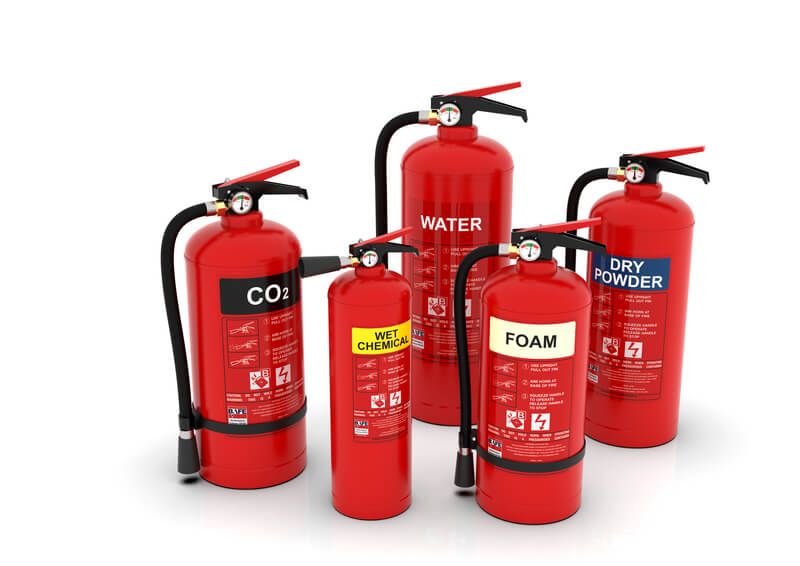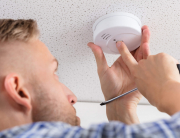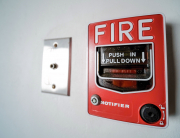Having the right fire extinguishers on hand is crucial for protecting lives and property in the event of a fire emergency. Fires can start unexpectedly and spread rapidly, so it’s important to be prepared with the proper equipment to quickly and effectively extinguish different types of fires. This guide will provide an overview of the main classes of fires and the various types of fire extinguishers available, helping you choose the right ones for your home or business.
Fire Classification: Understanding the Fuel Source
Before diving into extinguishers, we need to understand fire classification. Fires are categorised based on the fuel source that ignites them, influencing the most effective extinguishing agent. Here’s a breakdown of the common fire classes:
- Class A: Ordinary combustibles – This category encompasses fires involving common materials like wood, paper, textiles, and plastics. These fires typically leave an ash residue.
- Class B: Flammable liquids – These fires involve burning liquids such as gasoline, oil, grease, and paint. They spread rapidly and generate intense heat.
- Class C: Flammable gases – This class includes fires fueled by propane, methane, and natural gas. These fires can be explosive if not addressed promptly.
- Class D: Combustible metals – Magnesium, potassium, and sodium are some examples of metals that ignite under specific conditions. Class D fires require specialised extinguishing agents.
- Class E: Electrical fires – Fires involving energised electrical equipment fall under this category. Disrupting the electrical current is crucial before extinguishing the flames.
- Class F: Cooking oils and fats – This class covers fires involving burning cooking oils, common in restaurant kitchens.
Types of Fire Extinguishers
Now that we understand fire classifications, let’s explore the different types of fire extinguishers and their capabilities.
Water Extinguishers (Class A)
- Water extinguishers employ water to cool and smother Class A fires, which involve ordinary combustible materials such as wood, paper, and cloth.
- They are readily available, inexpensive, and highly effective on these types of fires.
- However, they are ineffective on flammable liquids and electrical fires and can cause water damage to property.
Water Mist Extinguishers (Class A & B)
- Water mist extinguishers use a fine water spray to quench fires. The smaller droplets offer better surface coverage and penetration compared to traditional water extinguishers, making them effective on Class A and some Class B fires.
- Additionally, they cause less water damage compared to standard water extinguishers.
- Despite these advantages, water mist extinguishers may not be suitable for all Class B fires, and their conductivity poses a risk when used on electrical fires.
Foam Extinguishers (Class A & B)
- Foam extinguishers discharge a foam blanket that smothers the fire and prevents oxygen from reaching the fuel source, making them effective on both Class A and Class B fires.
- They are versatile tools for tackling ordinary combustibles and flammable liquids.
- However, foam extinguishers are more expensive than water extinguishers and may leave a slippery residue.
Dry Chemical Extinguishers (Class A, B, & C)
- Dry chemical extinguishers release a powder that disrupts the chemical reaction of the fire, making them effective against Class A, B, and C fires.
- They are versatile and can handle multiple fire classes, including electrical fires.
- However, the powder can leave a residue that requires cleaning and may have limited effectiveness in windy conditions.
Carbon Dioxide (CO2) Extinguishers (Class B & C)
- CO2 extinguishers displace oxygen around the fire, causing suffocation, making them suitable for Class B and C fires.
- They use a clean extinguishing agent that leaves no residue and are particularly effective on electrical fires.
- However, they are ineffective on Class A fires, and the displacement of CO2 can pose a risk of suffocation in confined spaces.
Wet Chemical Extinguishers (Class F)
- Wet chemical extinguishers contain a saponifying agent that breaks down burning fats and oils, making them specifically designed for extinguishing Class F fires typically found in kitchens.
- While highly effective for kitchen fires involving cooking oils and fats, they are limited to Class F fires and are not suitable for other fire classes.
Specialist Dry Powder Extinguishers (Class D)
- Specialist dry powder extinguishers contain specialised powder formulations to extinguish fires involving specific combustible metals such as magnesium or sodium.
- These extinguishers are essential in workplaces where these metals are present, providing targeted fire-fighting capability for these unique fire hazards.
Choosing the Right Fire Extinguisher
Equipping yourself with the right fire extinguisher hinges on understanding your specific needs and potential fire hazards. Here are some key factors to consider:
- Fire Class: As discussed earlier, identify the most likely fire class you might encounter. Homes typically require Class A extinguishers for ordinary combustibles like paper and wood. Kitchens benefit from having both Class A and Class F extinguishers for regular fires and cooking oil emergencies, respectively.
- Work Environment: Offices might require Class A and C extinguishers for paper fires and electrical equipment malfunctions. Industrial settings with flammable liquids or specific combustible metals necessitate Class B or Class D extinguishers, respectively.
- Ease of Use: Consider the user’s familiarity with fire extinguishers. Water and water mist extinguishers are generally user-friendly. CO2 extinguishers require an understanding of suffocation risks. While dry chemical extinguishers offer versatility, the powder residue necessitates cleanup.
Fire Safety Essentials
While fire extinguishers are vital, a comprehensive fire safety strategy goes beyond them. Here are some additional practices to remember:
- Fire Alarms and Smoke Detectors: Ensure you have functioning fire alarms and smoke detectors in your home or workplace. Regularly test and maintain these devices.
- Escape Plans: Check your house and develop a fire escape plan for your home or workplace. Identify multiple exits and designate a meeting point outside.
- Fire Safety Training: Consider fire safety training for yourself and others in your household or workplace. Familiarise yourself with extinguisher operation and fire safety protocols.
Fire Extinguisher Maintenance and Inspection
Fire extinguishers are like insurance policies for fire emergencies. But just like any safety equipment, they require proper maintenance and inspection to function optimally. Here’s what you need to know.
- Conduct monthly visual inspections to ensure the extinguisher is free from physical damage, leaks, or corrosion. Check the pressure gauge to confirm it’s within the designated operating range.
- Schedule annual professional maintenance by a qualified technician. During this service, the extinguisher will be thoroughly inspected, internally discharged (for some types) to test functionality, and refilled if necessary.
- Maintain a logbook to document all inspections and maintenance performed on the fire extinguisher. This record serves as proof of proper care and helps identify any recurring issues.
How Can We Help?
Fire extinguishers are life-saving tools, but their effectiveness depends on proper selection, usage and maintenance. By familiarising yourself with the different types, fire classifications, and essential fire safety practices, you can make informed decisions about fire extinguisher selection and contribute to a safer environment for yourself and others. Remember, even a small fire can escalate quickly. Having the right fire extinguisher readily available and knowing how to use it effectively can be the difference between a minor incident and a major catastrophe.
Visit here for more fire safety tips in various formats. In addition, access government-approved fire safety leaflets from Gov.uk to stay informed and better equipped to handle fire emergencies. Consult with fire safety professionals to assess your specific needs and develop a comprehensive fire safety plan tailored to your environment.






